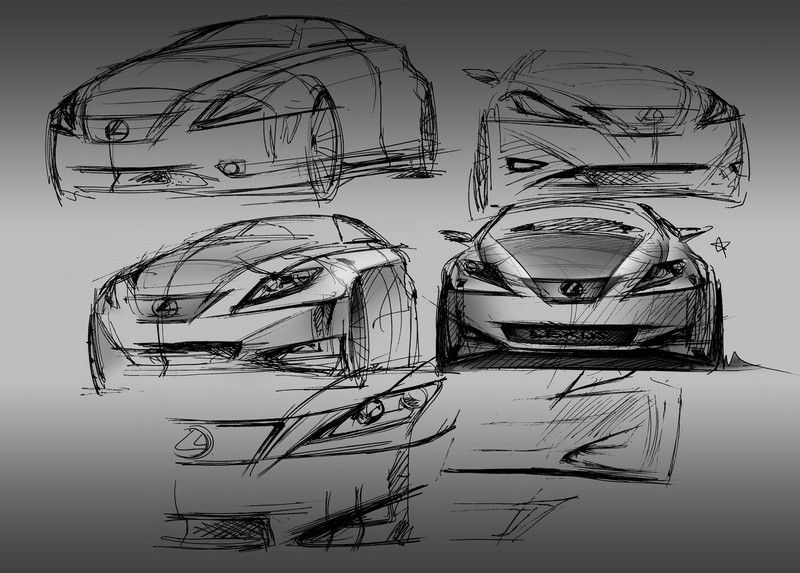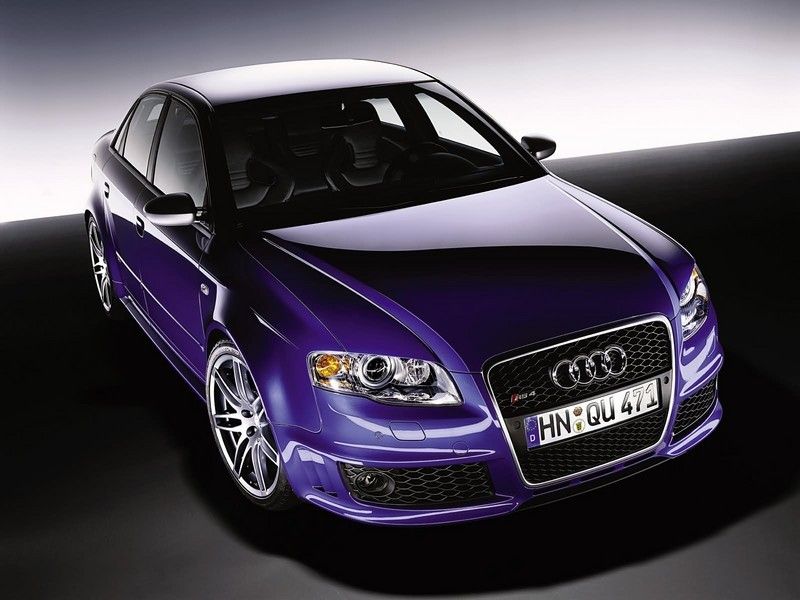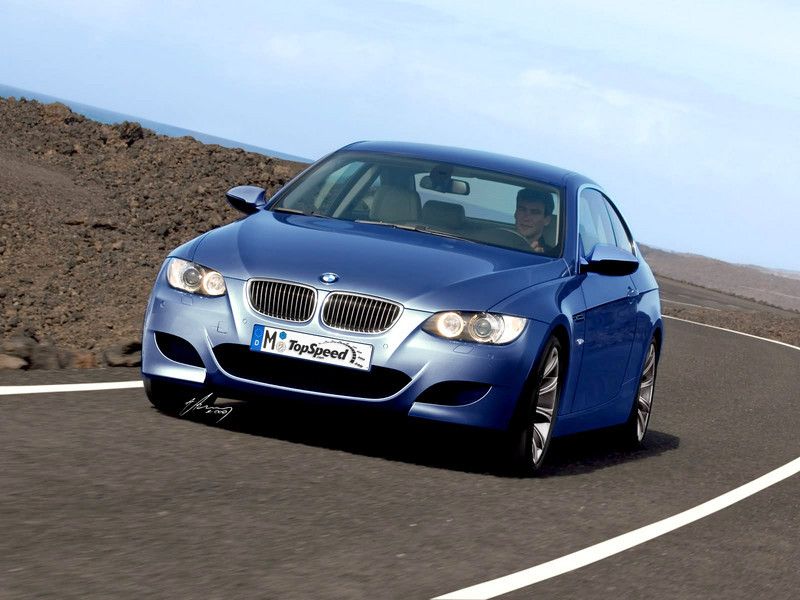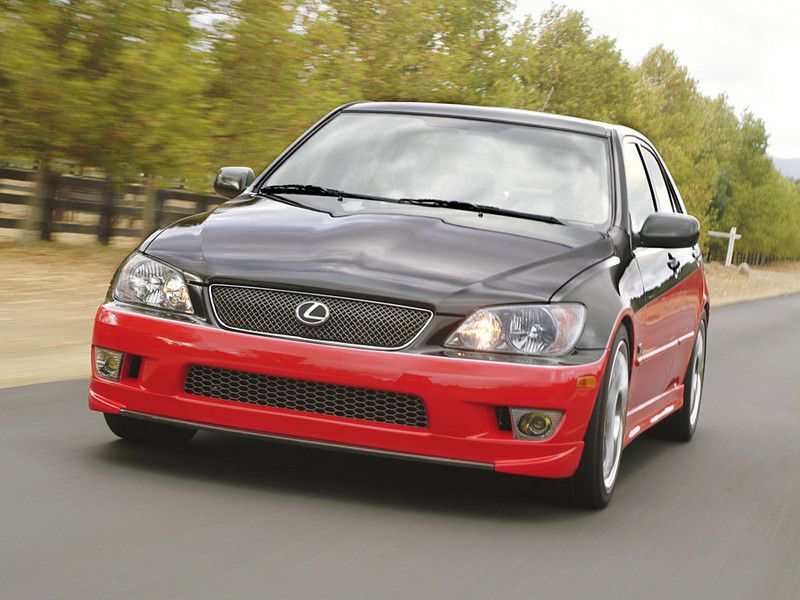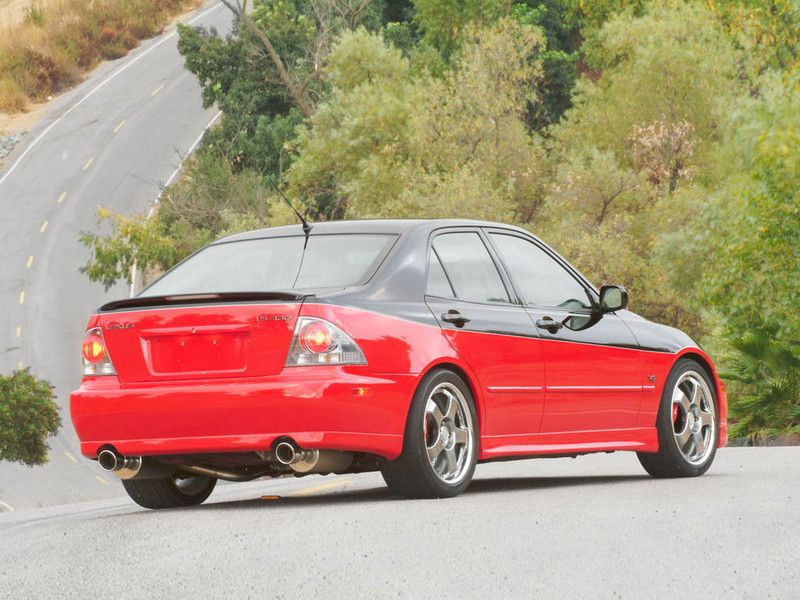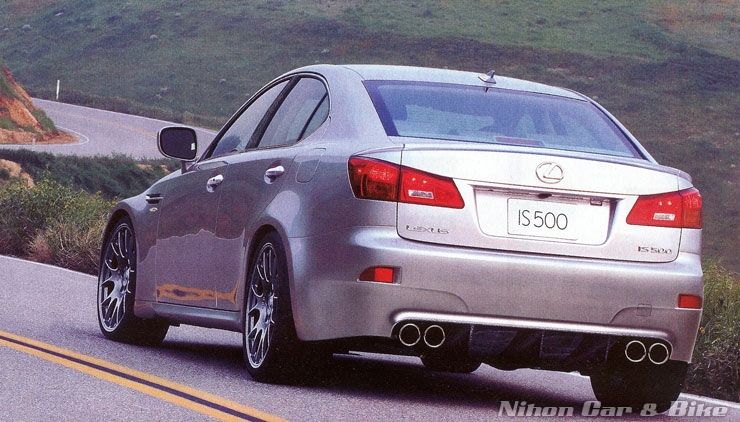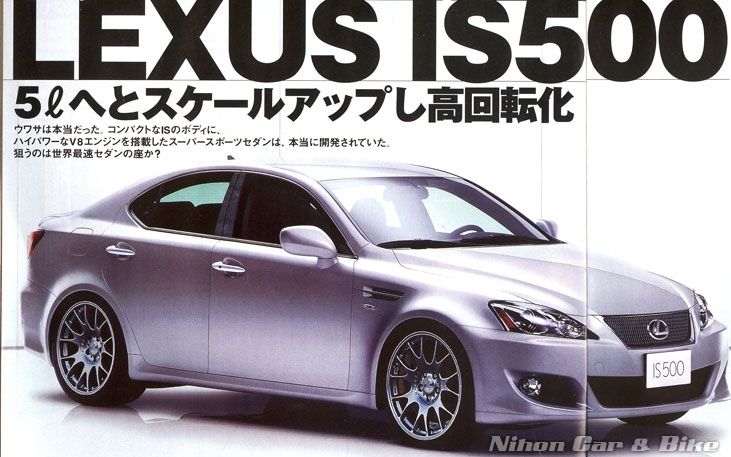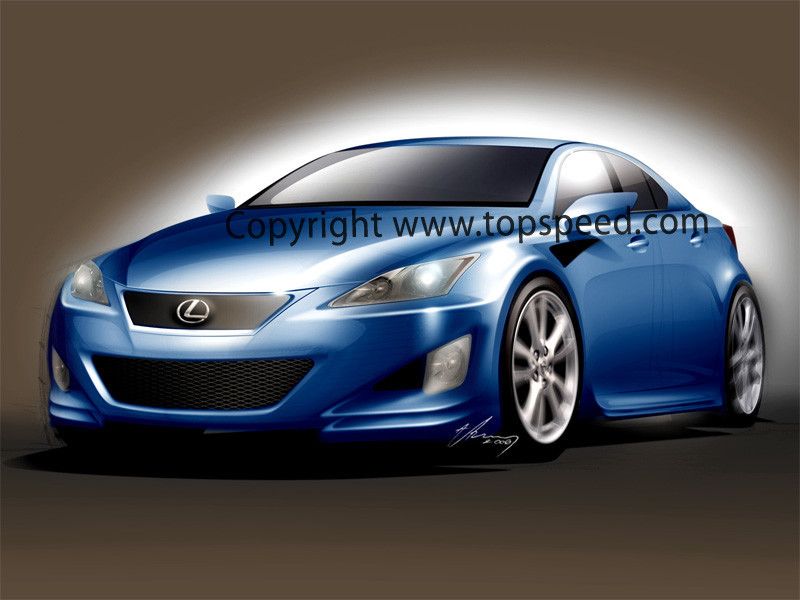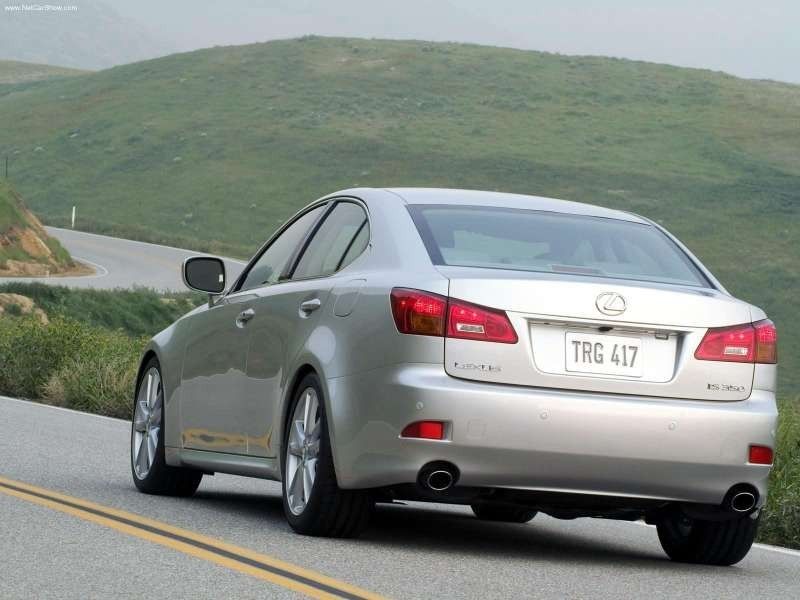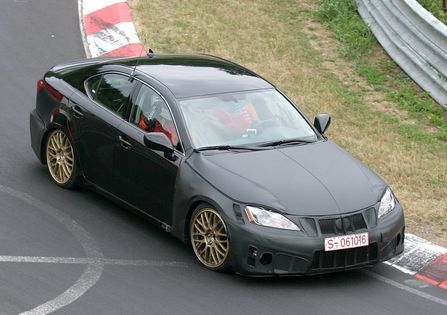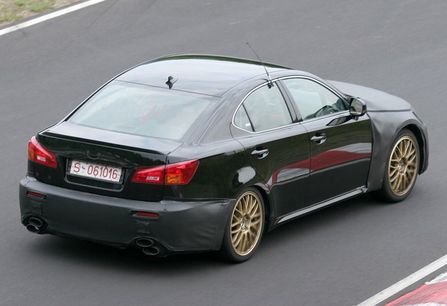The highly successful Lexus IS medium sedan series has already been trouble for the German BMW 3-Series, Audi A4 and Mercedes C-Class. It seems that Lexus will not settle with competing against the low and mid-end medium sedans, but is committed to dare the league of the “bad boys”. The new high-performance Lexus will be called IS500, will equip a 420 bhp V8 engine and will compete against the BMW M3 (E90), Audi RS4 and Mercedes C55 AMG.
2008 Lexus IS500 preview
- Make: Array
- Model: 2008 Lexus IS500 preview
- Engine/Motor: V8 DOHC 32 valves
- Horsepower: 420 @ 5800
- Torque: 405 @ 3800
- Transmission: 6-Speed Manual ?
- [do not use] Vehicle Model: Array
The Lexus IS series proved to be quite a successful medium sedan. While the larger Lexus models seem to be clones of the Mercedes equivalent models, the IS was aimed at the sportier BMW 3-Series. A very flourishing member of the 3-Series family is the sporty M3. Against this image vector Lexus didn’t had anything to offer. However, it seems that things are about to change as the Japanese company is developing an IS500 model.
The new IS500 has set as a performance target the Audi RS4 sedan and the E90 BMW M3, to be released. Both of this cars use V8 high-rev normally aspirated engines producing around 420 bhp
The new sports-saloon Lexus will probably feature a detuned version of the 5.0L V8 currently in development for the LF-A supercar production version. As first information show, for the IS500 the V8 ( code-named 2UR-FSE) engine will produce 420 bhp @ 5800 rpm and 405 lbs/ft of torque @ 3800 rpm from 5.0 liters of displacement. The new Lexus V8 will be a bored out version of the 4.6 L engine from the new Lexus LS460 saloon. This is a slower engine than those used by the German competitors (the RS4’s reaches 8250 rpm and the M3’s is expected to rev up to 9000) as Lexus has no experience on the high-revving principle. In order to compensate for that the Lexus has a bigger displacement, 5.0 L against 4.2 L in the Audi and 4.0 L in the BMW.
The new engine will feature the usually Lexus “goodies”, such as the “drive-by-wire” ETCS-i, (Electronic Throttle Control System intelligent), which will control the throttle based not just on pedal position, but also on data from vehicle speed and engine rpm. This system will team up with the engine’s intelligent Variable Valve Timing (VVT-i), which will ensures unmatched tractability and smoothness by optimizing valve overlap throughout the engine’s speed range. As a result, more torque will be available across a broader engine speed range, making the vehicle more reactive under all driving conditions and providing the driver with confidence in effortless passing power.
We expect an extensive use of lead-free alloys in components such as valve-seats and connecting rods, which will contribute to preserving the environment. An enhanced cylinder head cooling will increase combustion efficiency and contribute to lower emissions.
We present you a rendering provided by our artists to give a glimpse about the future car.
The expected overall dimensions of the new IS 500 are 183.6 inches in length, 71.6 inches in width and 56.5 inches in height. The wheelbase will measure 107 inches and the weight will be up to 3714 lbs. As we can notice the IS500 is has gained some width in comparison with the rest of the IS models as it sits on wider tracks. That led to more pronounced fender flares that need to cover the enlarged wheel/tire combo.
Two supposed images of the Lexus IS500 were published in April by Japanese “Car Top” magazine (we show you the scans courtesy of www.nihoncarandbike.com ). After analyzing the images, we concluded that they are Photoshop edited. The rear end spoiler with the quad exhaust pipes looks strikingly identical to that of a BMW M3. The boot lid aileron, on the other side is copied after an Audi RS4.
The new Lexus IS500 will feature a tuned version of the double wishbone front and multilink rear suspension configuration, common in all the ISes. That layout combines legendary Lexus ride comfort with excellent handling and dynamic abilities.
The front, high-mount, double wishbone suspension will combines a lightweight, forged aluminum knuckles with a high tensile steel lower arm and a hollow anti-roll bar. In addition, the new, forward mounted power steering gear allied to low toe variation along the suspension stroke will offer a more linear yaw response, precise steering control and excellent straight line, high speed stability.
The rear will equip, an advanced multilink set-up with toe control arms and an aluminum rear axle carrier that combine stiffer suspension component materials with a reduction in unsprung mass for excellent ride comfort with high cornering stability. The upper arms supply to a reduction in upward spring motion, the mid-arm contributes to reduced body roll, and the lower arm provides an improved anti-lift / anti-squat ratio. Moreover, aligning the shock absorbers along the same, lower axis as the coil springs facilitates a wider boot loadspace.
The braking system will feature high diameter ventilated and drilled discs with brake-fade pressure compensation system to constantly monitor brake performance. In addition, the new, high friction coefficient brake pads will further increase the IS500’s braking efficiency. The, link-type variable ratio brake pedal will provides a progressive action combining optimum low-deceleration feel with maximum high-deceleration power. Via this new brake system, the new IS500 will deploy a comprehensive range of active safety braking functions including Anti-lock Brakes (ABS), Traction Control (TRC), Vehicle Stability Control (VSC), Brake Assist System (BAS), Electronic Brake-force Distribution (EBD) and Hill-start Assist Control (HAC).
Prices are expected to start from around $60,000.
-----
History
The Lexus IS is the entry-level sedan produced by Lexus and was originally sold as the Toyota Altezza in Japan. It was designed to compete against the BMW 3 Series, Mercedes-Benz C-Class and Nissan Skyline/Infiniti G35 sports sedans.
The "IS" stands for "Intelligent Sport". The first-generation IS (codename XE10) was launched in Japan in October 1998, and made its debut in Europe in 1999 and in North America in 2001.
The second generation IS was redesigned for the 2006, and was introduced in the fall of 2005. The Altezza name ceased to be used as the Lexus name was introduced in Japan. A pre-production example of the second generation IS model was shown in the 2005 Geneva Auto Show.
A precedent for the IS500 exists in the Lexus history in the shape of a concept car unveiled at the 2003 Sema Show. The IS 430 concept sports sedan was powered by a 4.3 L V8 engine from a Lexus GS 430. The concept was intended to demonstrate the potential of the IS 300. In order to produce it Lexus commissioned Rod Millen Special Vehicles (RMSV) to build the car.
The potent V8 engine was mated with a Getrag 6-speed manual transmission and lightweight flywheel, which drove the rear wheels through a stronger limited slip differential and various GS 430 driveline components.
The concept had to deliver sharp handling while, while maintaining reasonable ride comfort and noise levels. TEIN springs and 16-way electronically adjustable shock absorbers were added to the original IS 300 front suspension in addition to selected GS 430 rear suspension components, which help ensure durability against the higher torque of the 4.3-liter V8. Big, sticky Michelin Sport Cup tires on 18-inch Speed Star SSR alloy wheels transferred the power to the ground.
The Lexus IS 430 was a one-off vehicle built to study of the considerable performance potential of the IS 300 luxury sport sedan and there were no production plans at that time.
Specs for 2003 Lexus IS 430 Concept
engine 3UZ -FE Aluminum V8
front brakes 14.0 in Brembro Vented & Cross-Drilled Discs, 4-Piston Calipers
rear brakes 13.6 in Brembro Vented & Cross-Drilled Discs, 4-Piston Calipers
front suspension Double Wishbones, TEIN springs, Electronically Adjustable Shock Absorbers
rear suspension Double Wishbones, TEIN springs, Electronically Adjustable Shock Absorbers
-----
Competition
The car that defines the sports sedan genre is definitely theBMW M3, and therefore that is one of the cars the Lexus IS500 will have to beat.
The BMW M3 is the sports version of the popular compact BMW 3-Series automobile, produced by BMW Motorsport division. The first M3 was based on the 1986s E30 range, and there has been an M version of every 3-Series since.
A new M-version of BMW’s E90 3-Series is scheduled for launch next year. The new M3 will be produced as coupe first, but a convertible and a sedan will be also available one year after production start. The new M3 will feature a 4.0 L V8 engine producing over 400 bhp, derived from the M5’s V10. Click here to read our complete E90 BMW M3 preview.
The car that rules the sports sedan segment at the moment is the Audi RS4, the highest performance version of the company's A4, sitting above the S4 in the lineup.
The first generation RS4 was introduced in 2000 as the successor to the fabled Porsche developed Audi RS2. The first RS4, like its predecessor, was available only as an Avant (station wagon), and was built on the "B5" generation A4/S4 platform. The car was available only to European customers.
After a long hiatus, the second generation RS4, was launched in the summer of 2005. It is built on Audi's "B7" A4 platform and was introduced in the US at the 2006 North American International Auto Show. On sale from August 2006, it has a US base price of $66,000.
The B7 RS4 is an almost complete departure from previous RS cars, as it is offered as a sedan, Avant and convertible. Only the RS6 has gone this route before, the previous RS4 and RS2 were available exclusively as Avants. The power comes for the first time in an RS from an FSI equipped, naturally aspirated 4.2 L V8 (whereas all previous RS cars have been turbocharged). Nonetheless, this engine is very powerful, producing a total output of 420 bhp and 317 ft/lbs of torque. Click here to read our in depth Audi RS4 review.

